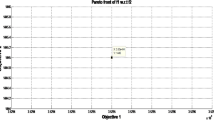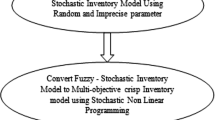Abstract
Real-world systems present a variety of challenges to the modeller, not least of which is the problem of uncertainty inherent in their operation. In this research, an interval type-2 fuzzy model is applied to a real-world problem, the goal being to discover a suitable optimisation configuration to enable a search for an inventory plan using the model. To this end, a series of simulated annealing configurations and the interval type-2 fuzzy model were used to search for appropriate inventory plans for a large-scale real-world problem. A further set of tests were conducted in which the performance of the interval type-2 fuzzy model was compared with a corresponding type-1 fuzzy model. In these tests the results were inconclusive, though, as will be discussed there are many ways in which type-2 fuzzy logic can be exploited to demonstrate its advantages over a type-1 approach. To conclude, in this research we have shown that a combination of interval type-2 fuzzy logic and simulated annealing is a logical choice for inventory management modelling and inventory plan search, and propose that the benefits that a type-2 model offers, can make it preferable to a corresponding type-1 system.




Similar content being viewed by others

References
Aliev RA, Fazlollahi B, Guirimov BG, Aliev RR (2007) Fuzzy-genetic approach to aggregate production-distribution planning in supply chain management. Inf Sci 177:4241–4255
Biglarbegian M, Melek W, Mendel J (2011) On the robustness of type-1 and interval type-2 fuzzy logic systems in modeling. Inf Sci Int J 181(7):1325–1347
Bouleimen K, Lecocq H (2003) A new efficient simulated annealing algorithm for the resource-constrained project scheduling problem and its multiple mode version. Eur J Oper Res 149(2):268–281
Fayad C, Petrovic S (2005) A fuzzy genetic algorithm for real-world job shop scheduling. In: Proceedings of the 18th international conference on Innovations in applied artificial intelligence, Bari, pp 524–533
Garibaldi JM, Ifeachor EC (1999) Application of simulated annealing fuzzy model tuning to umbilical cord acid-base interpretation. IEEE Trans Fuzzy Syst 7(1):72–84. ISSN:1063-6706
Hagras H (2004) A hierarchical type-2 fuzzy logic control architecture for autonomous mobile robots. IEEE Trans Fuzzy Syst 12(4):524–539
Hamrawi H, Coupland S (2009) Type-2 fuzzy arithmetic using Alpha-planes. In: Proceedings of the Joint 2009 International Fuzzy Systems Association World Congress and 2009 European Society of Fuzzy Logic and Technology conference, pp 606–611
John R, Coupland S (2007) Type-2 fuzzy logic a historical view. IEEE Comput Intell Mag 2(1):57–62
Karnik N, Mendel J (1999) Applications of type-2 fuzzy logic systems to forecasting of time-series. Inf Sci 120:89–111
Karnik N, Mendel J (2001) Centroid of a type-2 fuzzy set. Inf Sci 132:195–220
Kaufmann A, Gupta MM (1985) Introduction to fuzzy arithmetic: theory and applications. Van Nostrand Reinhold, New York. ISBN 0442230079
Kirkpatrick S, Gelatt CD Jr, Vecchi MP (1983) Optimization by simulated annealing. Science 220(4598):671–680
Klir GJ, Folger TA (1988) Fuzzy sets, uncertainty and information. Prentice Hall, Englewood Cliffs
Klir GJ, Wang Z, Harmanec D (1997) Constructing fuzzy measures in expert systems. Fuzzy Sets Syst 92:251–264
Melouk S, Damodaran P, Chang PY (2004) Minimizing makespan for single machine batch processing with non-identical job sizes using simulated annealing. Int J Prod Econ 87(2):141–147
Mendel J (2001) Uncertain rule-based fuzzy logic systems—introduction and new directions. Prentice Hall, Upper Saddle River, 07458
Mendel J (2007) Advances in type-2 fuzzy sets and systems. Inf Sci 177(1):84–110
Mendel J, John R (2002) Type-2 fuzzy sets made simple. IEEE Trans Fuzzy Syst 10(2):117–127
Mendel JM, John RI, Liu F (2006) Interval type-2 fuzzy logic systems made simple. IEEE Trans Fuzzy Syst 14(6):808–821
Miller S, Gongora M, John R (2010) Inventory optimisation with an interval type-2 fuzzy model. In: Proceedings of 2010 IEEE World Congress on Computational Intelligence (WCCI 2010). IEEE, Barcelona, pp 2077–2083, 18–23 July 2010
Miller S, Gongora M, Popova V (2009) A comparison of methods for optimising resource plans. In: Proceedings of the 9th annual workshop on computational intelligence (UKCI 09), Nottingham, pp 37–42, 7–9 Sept 2009
Miller S, John R (2010) An interval type-2 fuzzy multiple echelon supply chain model. Knowl Based Syst 23(4):363–368
Petrovic D, Xie Y, Burnham K, Petrovic R (2008) Coordinated control of distribution supply chains in the presence of fuzzy customer demand. Eur J Oper Res 185:146–158
Sakawa M, Mori T (1999) An efficient genetic algorithm for job-shop scheduling problems with fuzzy processing time and fuzzy duedate. Comput Ind Eng 36:325–341
Sanz JA, Fernández A, Bustince H, Herrera F (2010) Improving the performance of fuzzy rule-based classification systems with interval-valued fuzzy sets and genetic amplitude tuning. Inf Sci 180(19):3674–3685
Sanz J, Fernández A, Bustince H, Herrera F (2011) A genetic tuning to improve the performance of fuzzy rule-based classification systems with interval-valued fuzzy sets: degree of ignorance and lateral position. Int J Approx Reason 52(6):751–766
Tang O (2004) Simulated annealing in lot sizing problems. Int J Prod Econ 88(2):173–181
Wagner C, Hagras H (2007) A genetic algorithm based architecture for evolving type-2 fuzzy logic controllers for real world autonomous mobile robots. In: Proceedings of the IEEE international conference on fuzzy systems, London, pp 193–198
Wagner C, Hagras H (2010) An approach for the generation and adaptation of zslices based general type-2 fuzzy sets from interval type-2 fuzzy sets to model agreement with application to intelligent environments. In: Proceedings of 2010 IEEE World Congress on Computational Intelligence (WCCI 2010). IEEE, Barcelona, pp 650–657, 18–23 July 2010
Wang J, Shu Y-F (2005) Fuzzy decision modelling for supply chain management. Fuzzy Sets Syst 150(1):107–127
Zadeh LA (1965) Fuzzy sets. Inf Control 8(3):338–353
Zadeh LA (1973) Outline of a new approach to the analysis of complex systems and decision processes. IEEE Trans Syst Man Cybern 3(1):28–44
Acknowledgments
The research reported here has been funded by the Technology Strategy Board (Grant No. H0254E).
Author information
Authors and Affiliations
Corresponding author
Rights and permissions
About this article
Cite this article
Miller, S., Gongora, M., Garibaldi, J. et al. Interval type-2 fuzzy modelling and stochastic search for real-world inventory management. Soft Comput 16, 1447–1459 (2012). https://doi.org/10.1007/s00500-012-0848-y
Published:
Issue Date:
DOI: https://doi.org/10.1007/s00500-012-0848-y



